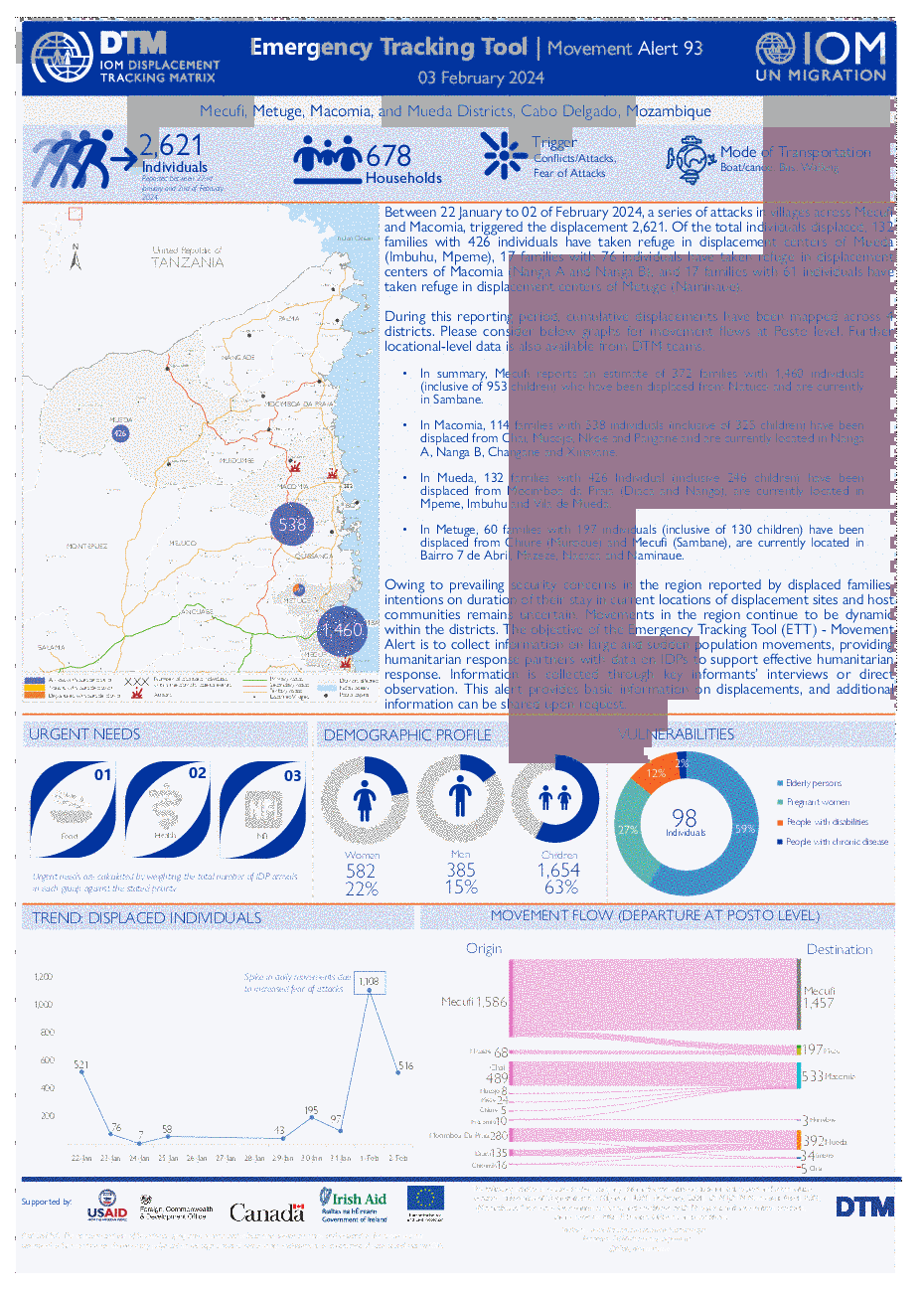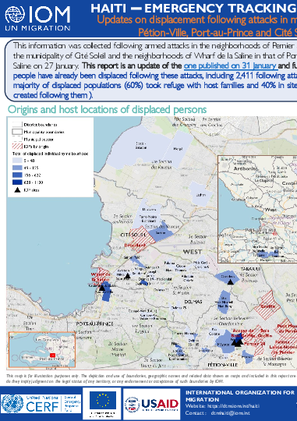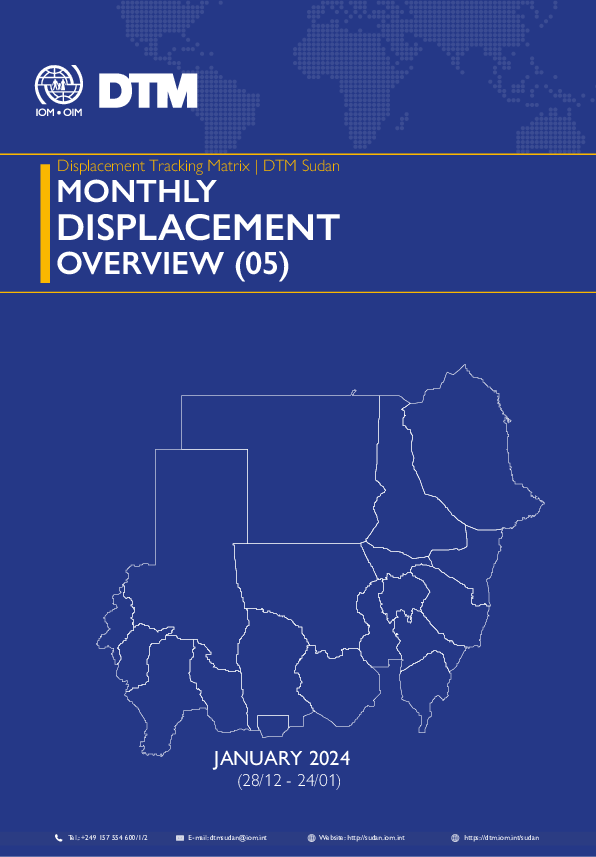-
Countries
-
Data and Analysis
-
Special Focus
-
Crisis Responses

Contact
DTMMozambique@iom.int
Language
English
Location
Mozambique
Period Covered
Jan 22 2024
Feb 02 2024
Activity
- Mobility Tracking
- Event Tracking
Between 22 January to 02 of February 2024, a series of attacks in villages across Mecufi and Macomia, triggered the displacement 2,621. Of the total individuals displaced, 132 families with 426 individuals have taken refuge in displacement centres of Mueda (Imbuhu, Mpeme), 17 families with 76 individuals have taken refuge in displacement centres of Macomia (Nanga A and Nanga B), and 17 families with 61 individuals have taken refuge in displacement centres of Metuge (Naminaue).

Contact
dtmhaiti@iom.int
Language
English
Location
Haiti
Period Covered
Jan 27 2024
Feb 02 2024
Activity
- Mobility Tracking
- Event Tracking
This information was collected following armed attacks in the neighborhoods of Pernier and its surroundings in the municipality of Pétion Ville, in the neighborhoods of Drouillard in the municipality of Cité Soleil and the neighborhoods of Wharf de la Saline in that of Port- au-Prince. Attacks in Pernier and Drouillard began on 30 January 2024 and at Wharf de la Saline on 27 January. This report is an update of the one published on 31 January and further updates will be published according to the evolution of displacement. A total of 4,327 people have already been displaced following these attacks, including 2,411 following attacks in Pernier, 1,239 following those at Wharf de la Saline as well as 677 in Drouillard. The majority of displaced populations (60%) took refuge with host families and 40% in sites (1,731 people in 6 sites including 4 existing sites before these incidents and 2 new sites created following them ).

Contact
DTM Europe, ROViennaDataResearch-Newsletter@iom.int
Language
English
Location
Republic of Moldova
Period Covered
Feb 01 2023
Jun 30 2023
Activity
- Survey
- Return Intention
The onset of the war in Ukraine has caused substantial displacement of people both within the Republic of Moldova’s borders and throughout the neighbouring region. The refugee situation is coupled with significant movement flows of Moldovan labour migrants returning from abroad, in particular from Ukraine, the Russian Federation, and other neighbouring countries. The effects of the Ukraine crisis, combined with the lingering consequences of the COVID-19 pandemic could potentially change the Republic of Moldova’s migration dynamics, leading to a decrease in emigration and an increase in the number of Moldovan citizens returning home.
This may have severe long term effects on the already strained Moldovan economy hindering its capacity to respond to the humanitarian and economic challenges attendant to the Ukrainian crisis. There are major gaps in data on Moldovan returnees, including information on their socio-economic profiles, needs and vulnerabilities as well as their intentions for their future. To fill those gaps the International Organization for Migration (IOM), as the leading inter-governmental organization promoting humane and orderly migration, has conducted a survey with Moldovan returnees in order to assess how the war in Ukraine has affected them.

Contact
DTM Ethiopia, DTMEthiopia@iom.int
Language
English
Location
Ethiopia
Period Covered
Jun 01 2023
Jun 30 2023
Activity
- Flow Monitoring
In order to increase the availability of evidence on rural to urban migration flows and trends, as well as needs, coping mechanisms and motivations of drought-affected persons, the International Organization for Migration (IOM) Data and Research Unit (DRU), through the Displacement Tracking Matrix (DTM) methodology, set up two internal Flow Monitoring Points (FMPs) in Gode and Jigjiga, two major urban centres in the Somali region of Ethiopia.
This dashboard focuses on data collected in June 2023 through the Flow Monitoring Registry (FMR) tool in Gode and Jigjiga FMPs. In June 2023, 11,228 movements were observed, 7,006 of which were through Gode FMP (62.40%) and 4,222 through Jigjiga FMP (37.60%).

Contact
DTMMozambique@iom.int
Language
English
Location
Mozambique
Period Covered
Feb 01 2024
Feb 02 2024
Activity
- Mobility Tracking
- Event Tracking
Between 22 January to 01 of February 2024, a series of attacks in villages across Mecu and Macomia, triggered the displacement 2,105 across Mecufi, Metuge, Macomia, and Mueda Districts. Of the total individuals displaced, 132 families with 426 individuals have taken refuge in displacement centers of Mueda (Imbuhu, Mpeme), 16 families with 74 individuals have taken refuge in displacement centers of Macomia (Nanga A and Nanga B), and 17 families with 61 individuals have taken refuge in displacement centers of Metuge (Mieze).

Contact
DTM Sudan, DTMSudan@iom.int
Language
English
Location
Sudan
Period Covered
Dec 28 2023
Jan 24 2024
Activity
- Mobility Tracking
- Baseline Assessment
Overview
IOM DTM Sudan presents its fifth Monthly Displacement Overview. This publication provides an account of Sudan’s displacement context since 15 April 2023 – outlining population caseloads and movements, as well the present and evolving needs of Sudan’s growing IDP caseload.
Rationale
Recognizing the need for more detailed insights into the IDP situation, including the priority needs, access to services, movement intentions, and demographic breakdowns of the affected population, DTM Sudan has undertaken a comprehensive review of our data collection tool. In collaboration with a wide range of internal and external stakeholders, we have developed a new tool to better inform humanitarian response operations, aligning with the DTM global methodology. Leveraging our extensive network of approximately 367 field-based enumerators and a robust system of over 3,094 key informants across the country, DTM has gathered data on IDPs across 6,547 locations, in 177 of Sudan’s 189 localities – across all of Sudan’s 18 states.
Key Findings
- DTM Sudan estimates that 6,092,788 Individuals (1,213,683) Households) have been recently internally displaced.
- IOM DTM also reports that an estimated 1,720,890 mixed cross-border movements have been made into neighbouring countries.
- Since 15 April 2023, 45 per cent of the IDP caseload sought refuge in the Darfur and Kordofan regions, whereas 55 per cent were observed across the Northern, Eastern, and Central states.
- The majority of the IDP caseload (67%) were seeking shelter with the host community.
- While food security remains the highest priority need, health and non-food items are also growing concerns.
Contact
DTM Pakistan, DTMPakistan@iom.int
Location
Pakistan
Activity
- Survey
- Flow Monitoring
Period Covered
Jan 01 2023 -Dec 31 2023
The International Organization for Migration (IOM) in Pakistan collects data on the outflows of Afghans at the Torkham (Khyber Pakhtunkhwa) and Chaman (Balochistan) border crossing points (BCPs) to better understand the movements of Afghans returning to Afghanistan. The dataset is harmonised with those from the United Nations High Commissioner for Refugees (UNHCR), who also cover Ghulam Khan (Khyber Pakhtunkhwa), Badini and Bahramcha (Balochistan).
A more detailed version of this dataset containing information about the vulnerabilities is available, to get access kindly click on the 'Request Access' button
Population Groups
Returnee (Previously Displaced Abroad)
Survey Methodology
Unit of Analysis Or Observation
Other
Type of Survey or Assessment
Keywords
Geographical Scope
Administrative boundaries with available data
The current dataset covers the following administrative boundaries

Contact
DTM South Sudan, SouthSudanDTM@iom.int
Language
English
Location
South Sudan
Period Covered
Jan 01 2024
Jan 27 2024
Activity
- Survey
- Displacement Solutions
- Return Intention
On 27 January 2024, the IOM’s Displacement Tracking Matrix (DTM) in collaboration with WFP, ACTED, LWF, and Save the Children conducted a rapid intention survey in Renk TC and its adjacent area to understand the return intentions of the population, preferred destinations of return as well as reasons for choosing to remain in the transit center.

Contact
dtmlebanon@iom.int
Language
English
Location
Lebanon
Period Covered
Oct 10 2023
Jan 30 2024
Activity
- Mobility Tracking
- Baseline Assessment
Since October 8 there has been an increase in cross-border incidents between Israel and Lebanon, resulting in the displacement of people both within the South and elsewhere within the country. Since October 10, the Displacement Tracking Matrix (DTM) has been conducting the daily monitoring of population movements. The objective of the exercise is to inform preparedness and response planning.

Contact
DTMAfghanistan@iom.int
Language
English
Location
Afghanistan
Period Covered
Feb 21 2024
Feb 27 2024
Activity
- Survey
- Flow Monitoring Survey
- Flow Monitoring
In response to recent movements, IOM Afghanistan re-launched its DTM Flow Monitoring activity at the beginning of 2024 to better understand the mobility dynamics at Afghanistan’s borders. Since 10 January, DTM has deployed field teams at four border crossing points with the Islamic Republic of Iran (IRN) and Pakistan (PAK) (see map below) to conduct two interlinked exercises. The first is a headcount of all individuals entering or leaving Afghanistan (including returnees), also called Flow Monitoring Counting (FMC), to gauge flow volume. The second is a survey of randomly selected individuals or groups entering or leaving Afghanistan, also called the Flow Monitoring Survey (FMS), to understand the profiles, motivations, and vulnerabilities of the target population. This snapshot provides key findings combining various IOM data sources, including IOM Afghanistan’s Cross-Border Post-Arrival Humanitarian Assistance (CB-PAHA) program as well as DTM Afghanistan and Pakistan for the period 21 to 27 January 2024. For more information about methodology, see the last page of this report.